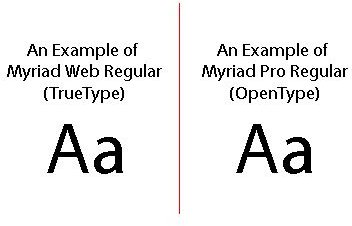OpenType vs. TrueType Font Formats: What's the Difference?
TrueType
Th
e TrueType format was developed by Microsoft and Macintosh in the late 80s to compete with Adobe’s PostScript format. TrueType (.ttf) files were the first to include the data for both how the fonts appear on-screen and how they appear when printed on paper. TrueType fonts are often packaged with both Microsoft and Mac products as the default typefaces available.
OpenType

OpenType (.otf) font files are the newer of the two file formats. OpenType was developed by Adobe and Microsoft. Like TrueType, OpenType files can contain both the data for fonts to appear on-screen and how they appear after being printed. OpenType supports storage for 65,000 characters making it incredibly useful for developers to include add-ons for their fonts that would have normally required the distribution of a second font.
Development
OpenType is quickly become the industry standard as it allows type designers the ability to utilize a large amount of storage for additional characters that would have to be distributed separately if saved in TrueType. TrueType was developed in the 1980s making it a rapidly aging technology that Microsoft no longer supports development for in favor of their partnership with Adobe on OpenType.
Distribution
Both file types are common and should be considered industry standards, and they can be distributed between both Macintosh and Microsoft systems. The TrueType format is still the more common format due to its ease to install and coming in software as the default font.
Since OpenType is still a newly developed format users might run into compatibility issues with older programs or software that requires updates. However, most OpenType fonts have the luxury of being able to be saved in both .otf and .tff formats, making them highly compatible and just as easy to distribute. Any OpenType files that cannot be saved as TrueType are usually much larger than what TrueType can handle and are often labeled as OpenType Pro files when the typeface is distributed.
Quality
Bo

th TrueType and OpenType are incredibly clean and switching between the two creates no noticeable loss in quality or unseemly pixels you might see with .jpeg format compression.
Which Format Is Better?
Both formats are very strong on their own and should be consider as equals presently. OpenType is great for type designers because of the space it offers and the ability to distribute as both OpenType and TrueType. TrueType is the easiest to install and distribute making it ideal for those looking to add new fonts to their word-processing software. OpenType will likely phase out its remaining competition completely as more systems begin supporting it.
Image Credits
The TrueType logo is under Creative Commons License and available at: https://commons.wikimedia.org/wiki/File:Exquisite-font_truetype.png
The OpenOffice logo was created for this article by: Amber Neely
The side-by-side comparison image was created for this article by: Michael Guerrero
